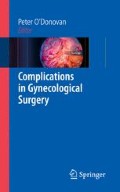Abstract
Severe complications associated with laparoscopy are rare, but as a large number of laparoscopies are carried out each year, the impact and consequence of these complications are considerable. The complications maybe life threatening, and the consequences of damage to the bowel, major blood vessels, and urinary tract are potentially catastrophic, leading to considerable physical and emotional suffering as well as significant financial cost.
Access this chapter
Tax calculation will be finalised at checkout
Purchases are for personal use only
Preview
Unable to display preview. Download preview PDF.
References
Phillips JM, Hulka J, Hulka B, et al. American Association of Gynecologic Laparos-copists’ 1976 membership survey. J Reprod Med. 1978;21:3–6.
Peterson HB, DeStefano F, Rubin GL, et al. Deaths attributable to tubal sterilization in the United States, 1977 to 1981. Am J Obstet Gynecol. 1983;146:131–136.
Lehmann-Willenbrock E, Riedel HH, Mecke H, et al. Pelviscopy/laparoscopy and its complications in Germany, 1949-1988. J Reprod Med. 1992;37:671–677.
Hulka J, Peterson HB, Phillips JM, et al. Operative laparoscopy: American Association of Gynecologic Laparoscopists’ 1993 membership survey. J Am Assoc Gynecol Laparosc. 1995;2:133–136.
Jansen FW, Kapiteyn K, Trimbos-Kemper T, et al. Complications of laparoscopy: a prospective multicenter observational study. Br J Obstet Gynaecol. 1997;104: 595–600.
Querleu D, Chapron C. Complications of gynecologic laparoscopic surgery. Curr Opin Obstet Gynecol. 1995;7:257–261.
Bateman BG, Kolp LA, Hoeger K. Complications of laparoscopy: operative and diagnostic. Fertil Steril. 1996;66:30–35.
Saidi MH, Vancaillie TG, White AJ, et al. Complications of major operative laparoscopy. A review of 452 cases. J Reprod Med. 1996;41:471–476.
Härkki-Siren P, Kurki T. A nationwide analysis of laparoscopic complications. Obstet Gynecol. 1997;89:108–112.
Chapron C, Querleu D, Bruhat MA, et al. Surgical complications of diagnostic and operative gynaecological laparoscopy: a series of 29,966 cases. Hum Reprod. 1998;13:867–872.
MacCordick C, Lecuru F, Rizk E, et al. Morbidity in laparoscopic gynecologic surgery: results of a prospective single-center study. Surg Endosc. 1999;13: 57–61.
Mirhashemi R, Harlow BL, Ginsburg ES, et al. Predicting risk of complications with gynecologic laparoscopic surgery. Obstet Gynecol. 1998;92:327–331.
Härkki-Siren P, Sjoberg J, Kurki T. Major complications of laparoscopy: a follow-up Finnish study. Obstet Gynecol. 1999;94:94–98.
Quasarano RT, Kashef M, Sherman SJ, et al. Complications of gynecologic laparoscopy. J Am Assoc Gynecol Laparosc. 1999;6:317–321.
Leonard F, Lecuru F, Rizk E, et al. Perioperative morbidity of gynecologic laparoscopy. A prospective monocenter observational study. Acta Obstet Gynecol Scand. 2000;79:129–134.
Levy BS, Hulka JF, Peterson HB, et al. Operative laparoscopy: American Association of Gynecologic Laparoscopists, 1993 membership survey. JAm Assoc Gynecol Laparosc. 1994;1:301–305.
Mintz M. Risks and prophylaxis in laparoscopy: a survey of 100,000 cases. J Reprod Med. 1977;18:269–272.
Lofferf FD, Pent D. Indications, contra-indications and complications of laparoscopy. Obstet Gynecol Surv. 1975;30:407–423.
Berqvist D, Berqvist A. Vascular injuries during gynaecological surgery. Acta Obstet Gynecol Scand. 1987;66:19–23.
Querleu D, Chevallier L, Chapron C, Bruhat MA. Complications of gynaecological laparoscopic surgery: a French collaborative study. Gynaecol Endosc. 1993;2: 3–6.
Chapron C, Querleu D, Bruhat MA, et al. Surgical complications of diagnostic and operative gynaecological laparoscopy: a series of 29,966 cases. Hum Reprod. 1998;13:867–872.
Harkki-Siren P. The incidence of entry related laparoscopic injuries in Finland. Gynaecol Endosc. 1999;8:335–338.
Garry R. Laparoscopic surgery. Best Pract Res Clin Obstet Gynaecol. 2006;20:89–104.
Garry R. Towards evidence based laparoscopic entry techniques: clinical problems and dilemmas. Gynaecol Endosc. 1999;8:315–326.
Hashizume M, Sugimachi K. Needle and trocar injury during laparoscopic surgery in Japan. Surg Endosc. 1997;11:1198–1201.
Chapron CM, Pierre F, Lacroix S, et al. Major vascular injuries during gynecologic laparoscopy. J Am Coll Surg. 1997;185:461–465.
Baggish MS. Analysis of 31 cases of major vessel injury associated with gynecologic laparoscopy operations. J Gynecol Surg. 2003;19:63–68.
Yuzpe AA. Pneumoperitoneum needle and trocar injuries in laparoscopy. A survey on possible contributing factors and prevention. J Reprod Med. 1990;35:485–490.
Nezhat C, Childers J, Nezhat F, et al. Major retroperitoneal vascular injury during laparoscopic surgery. Hum Reprod. 1997;12:480–483.
Champault G, Cazacu F, Taffinder N. Serious trocar accidents in laparoscopic surgery: a French survey of 103,852 operations. Surg Laparosc Endosc. 1996; 6:367–370.
Crist DW, Gadacz TR. Complications of laparoscopic surgery. Surg Clin North Am. 1993;73:265–289.
Krebs HB. Intestinal injury in gynecologic surgery: a ten year experience. Am J Obstet Gynecol. 1986;155:509–514.
Audebert AJM. The role of microlaparoscopy for safer wall entry: incidence of umbilical adhesions according to past surgical history. Gynaecol Endosc. 1999;8:363–367.
Hasson HM. A modified instrument and method for laparoscopy. Am J Obstet Gynecol. 1971;110:886–887.
Hasson HM. Open laparoscopy as a method of access in laparoscopic surgery. Gynaecol Endosc. 1999;8:353–362.
Penfield AJ. How to prevent complications of open laparoscopy. J Reprod Med. 1985;30:660–663.
Bonjer HJ, Hazebroek EJ, Kazemier G, et al. Open versus closed establishment of pneumoperitoneum in laparoscopic surgery. Br J Surg. 1997;84:599–602.
Australian Safety and Efficacy Register of New Interventional Procedures-Surgical (ASERNIP-S). A Systematic Review of the Methods Used to Establish Laparoscopic Pneumoperitoneum. Adelaide, South Australia: ASERNIP-S; 2001. ASERNIP-S Report No. 13.
Garry R. A consensus document concerning laparoscopic entry techniques: Middlesbrough, March 19-20 1999. Gynaecol Endosc. 1999;8:403–406.
Reich H, Riberio SC, Rasmussen C, et al. High-pressure trocar insertion technique. J Soc Laparoendosc Surg. 1999;3:45–48.
Tsaltas J, Pearce S, Lawrence A, et al. Safer laparoscopic trocar entry: it’s all about pressure. Aust N Z J Obstet Gynaecol. 2004;44:349–350.
McGurgan, P, O’Donovan P. Optical Verres as an entry technique. Gynaecol Endosc. 1999;8:379–382.
Garry R. Complications of laparoscopic entry. Gynaecol Endosc. 1997;6:319–329.
Author information
Authors and Affiliations
Editor information
Editors and Affiliations
Rights and permissions
Copyright information
© 2008 Springer-Verlag London Limited
About this chapter
Cite this chapter
Ogah, J.A. (2008). Laparoscopic Surgery. In: O’Donovan, P. (eds) Complications in Gynecological Surgery. Springer, London. https://doi.org/10.1007/978-1-84628-883-8_8
Download citation
DOI: https://doi.org/10.1007/978-1-84628-883-8_8
Publisher Name: Springer, London
Print ISBN: 978-1-84628-882-1
Online ISBN: 978-1-84628-883-8
eBook Packages: MedicineMedicine (R0)

